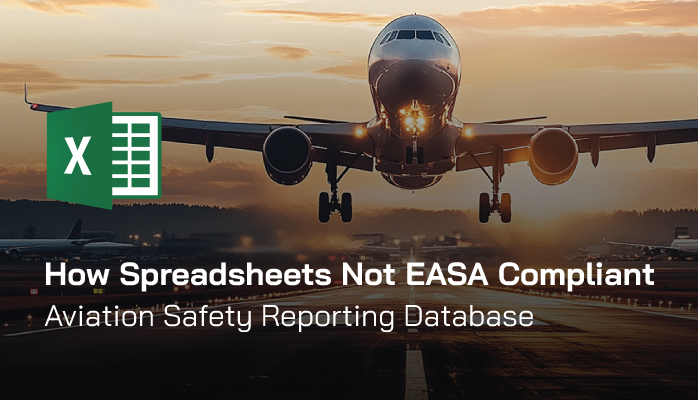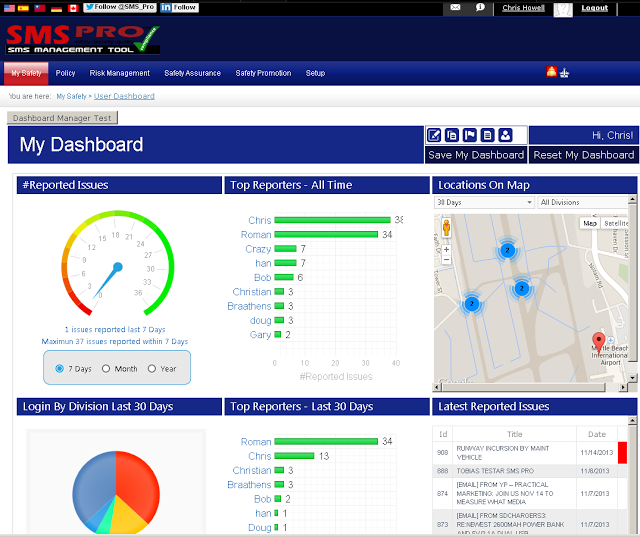Aviation Safety Reporting Database Required - Spreadsheets Equal Noncompliance

Empirical evidence and results from historical aviation accident investigations have shown that accidents are often preceded by safety-related incidents that reveal the presence of untreated hazards.
These "leading indicators" are commonly known to employees and are usually not formally reported in an aviation safety management system (SMS) database.
Leading indicators can take one of several forms:
Related Aviation Safety Leading Indicators Articles
- What Are Leading Indicators in Aviation SMS?
- How to Use Leading Indicators in Aviation SMS
- Understand Aviation SMS KPIs Lagging and Leading Indicators
Encouraging employees to report potential aviation safety hazards is incredibly important to reducing operational risk to ALARP (as low as reasonably practical). Many companies today are still gathering their hazard reports in Excel spreadsheets. Some companies believe they practice modern SMS best practices by using online spreadsheets, such as Google Sheets.
Regardless of which spreadsheet flavor you use, spreadsheets are not a best practice to store aviation safety reports. Unless you are a very small operator or an operator who is content to simply "check the SMS box" or have a "paper SMS," spreadsheets are not practical for storing and managing reported safety concerns. For example, a spreadsheet SMS is unable to:
- automatically alert management when safety items are overdue;
- track corrective actions and preventive actions;
- be worked on in a collaborative environment (as a team) and document individual contributions;
- document an audit trail of how reported safety concerns are treated, when and by whom;
- integrate with hazard register with risks and risk control data;
- generate PDF reports to send to third parties;
- automatically detect trends and alert management; or
- efficiently process ongoing investigations.
If you are now operating in Europe, you will be violating EASA regulations by storing safety report information in only spreadsheets. You will need a database. Several low-cost, commercially available SMS database solutions cost less than $200 per month. This is perhaps the easiest, but definitely not the cheapest alternative.
From an auditor's perspective, a spreadsheet SMS tells a lot about a company:
- They are disorganized or don't understand data management strategies;
- This operation doesn't care about SMS and is doing the bare minimum to address SMS requirements;
- Upper management's goals are not aligned with the intent of the SMS; or
- The company has a very limited budget.
EASA Compliance Requires Hazard Safety Reports Stored in Database
EASA regulations specifically require that all safety reports be stored in a database. If you are not storing your hazard reports in a database, then you are not in compliance.
Section 16 of EASA Regulation No. 376/2014 states:
To facilitate information exchange, occurrence reports should be stored in databases which should be compatible with the European Coordination Centre for Aircraft Incident Reporting Systems (ECCAIRS) (the software used by all Member States and by the European Central Repository to store occurrence reports) and with the ADREP taxonomy (the International Civil Aviation Organisation (ICAO) taxonomy, also used for the ECCAIRS software).
An Excel Spreadsheet Is not a Database.
Furthermore, Article 6,
Collection and storage of information "explicitly states in section #5:"
Organisations shall store occurrence reports drawn up on the basis of details of occurrences collected in accordance with Articles 4 and 5 in one or more databases.
Related Articles on Using Spreadsheets in Aviation SMS
- Why EASA Aviation Service Providers Require Safety Reporting Database
- 5 Things Spreadsheets Can’t Do for Your SMS
- Spreadsheets vs Software for Aviation Safety Management
Aviation Safety Databases Will Be Accepted Gradually

Safety managers operating in EASA jurisdiction have been aware that databases are required. One thing I've learned over the years about the aviation industry is that "almost everybody waits until the last minute to comply."
The EASA database requirement is no exception. I'm sure there are still hundreds of aviation service providers still using spreadsheets. They will change when:
- They are audited and found in non-compliance; or
- Safety managers convince management of their pressing needs.
I'm guessing it will take 36-48 months before all spreadsheets are phased out.
One hindrance to compliance is the lack of leadership among national aviation authorities. More than once, I've heard aviation safety managers tell me that their NAAs were not ready for the EASA 376/2014 regulation. That has been changing, as we are seeing more and more NAAs that have websites for accepting safety reports that can be sent directly to ECCAIRS.
Aviation Safety Hazards Stored in Home-Grown Databases
A sharp eye would have caught that
Occurrence reports should be stored in databases which should be compatible with the European Coordination Centre for Aircraft Incident Reporting Systems (ECCAIRS).
Just as there are many operators using spreadsheets for safety occurrence reporting, other European operators may have an MS Access database that a power user created years ago. To bring the home-grown database into compliance, there will have to be several modifications to the safety reporting database for ECCAIRS compatibility.
For some companies, the cost of modifying existing hazard reporting databases will exceed the cost of subscribing to a modern, low-cost, full-featured aviation SMS database solution.
Related Aviation SMS Database Articles
- 5 Most Important Things to Know Before Buying Aviation SMS Database
- 7 Signs You Need an Aviation Safety Management (SMS) Database
- Pros and Cons of In-House SMS Database and Off-the-Shelf-Solutions (COTS)
Final Thoughts on EASA Compliant Safety Occurrence Databases

Safety managers often complain that their NAAs are not providing adequate guidance or leadership for SMS compliance. Their complaints are usually justified. If your company is developing your aviation safety occurrence reporting database around the guidance of your NAA, then you may want to think about this again.
We often see NAAs or civil aviation authorities (CAAs) offer solutions to service providers that are not scalable. That is, their preferred solutions are not designed to grow with your company. An example of this is the spreadsheet templates that many CAAs have been giving out for many years.
The CAAs are not the only ones guilty of offering these limiting spreadsheet templates. Aviation safety consultants are also to blame. In their interest of offering "a solution," albeit a bad one, aviation safety consultants have been giving out these spreadsheet templates for years.
Agreed, these spreadsheet templates were "a solution," but now it's time for your aviation SMS data management strategy to mature and get rid of those spreadsheets. Otherwise, you will be spending too much time on SMS documentation requirements. When SMS documentation takes up too much time for the safety team, there are expected results:
- Safety team does a fast, but sloppy task of organizing and classifying data;
- Safety team procrastinates repeatedly until many documentation tasks go unfinished; or
- No safety promotion activities will come from the safety team.
The good news is that among the best aviation SMS software providers, there are tools to import your spreadsheets into their aviation SMS databases. Alternatively, their support staff can:
- Analyze your data;
- Devise data mapping strategies; and
- Write data import scripts.
All of this can be done at a modest charge and you will not be forced to abandon your legacy safety data.
SMS Database Videos
These short demo videos will show you how your SMS can benefit from low-cost SMS database software.
Live SMS Pro Demo
Have questions? Would you like to see SMS Pro live?
Sign up for a live demo.
Last updated January 2025.








